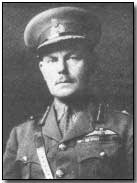Who's Who - Edward Ashmore
 General Edward Bailey Ashmore
(1872-1953) was an air defence pioneer whose talents came to fruition during
the First World War.
General Edward Bailey Ashmore
(1872-1953) was an air defence pioneer whose talents came to fruition during
the First World War.
Ashmore entered the Royal Artillery in 1891 and served in South Africa before attending the Staff College.
Ashmore's war in 1914 began as a Major. Having joined the reserve of the Royal Flying Corps he subsequently became commander of an RFC brigade in France in 1915.
Returning to England two years later he was given the rank of Major-General and handed command of London's air defences, then under increasing night fire from the German air force.
Ashmore worked to establish principles of early air raid warnings, and to ensure rapid response by intercepting forces. He also emphasised the importance of adequate air raid procedures. He setup a series of observation positions ranging from London to the Channel coast, and which acted to provide a measure of early warning.
Once German aircraft had crossed the Channel a system of anti-aircraft weaponry, barrage balloons and searchlights were put into play. London was not infrequently subject to blackouts in an attempt to foil the incoming German aircraft. The development of adequate two-way radio in 1918 was quickly put to effective use by Ashmore.
During the 1920s Ashmore played a prominent role in the establishment of the Royal Observer Corps. The Second World War saw Ashmore's principles of air defence once again put to practical use.
He died in 1953.
A "salient" is a battle line that projects into territory nominally held by enemy forces.
- Did you know?
